|
|
 |
 |
 |
 |
|
Emtac
Bluetooth GPS Receiver |
11th December
2002 |
|
|
Well there has been a lot of us GPS
fanatics with iPAQ 3870 and 3970 or other Bluetooth enabled computers
eagerly awaiting the advent of the next level of GPS receivers.
That day has arrived with the launch of the Emtac BT GPS receiver.
The World's first wireless GPS receiver using the new BlueTooth
Technology. |
 |
|
Is
it as good as we were expecting? Was it worth the wait? Read on
and find out...
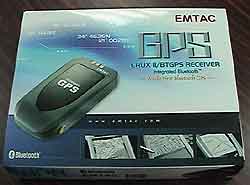 The
review unit was provided to us by Itochu Europe PLC, the UK importer
and distributor of Emtac products. Itochu corporation is the exclusive
distributor of EMTAC BTGPS on the worldwide market. They provide
OEM units to Socket in Europe and America and sell the BT GPS receiver
with the Emtac brand name. The
review unit was provided to us by Itochu Europe PLC, the UK importer
and distributor of Emtac products. Itochu corporation is the exclusive
distributor of EMTAC BTGPS on the worldwide market. They provide
OEM units to Socket in Europe and America and sell the BT GPS receiver
with the Emtac brand name.
Itochu UK is the distributor
of Emtac in the UK, Itochu France, is the distributor of EMTAC in
western Europe (except UK and Italy), Texmac, another subsidiary
of Itochu Corporation group is the exclusive in Italy and Eastern
Europe.
At the time of writing
Expansys
were advertising the receiver for £272.98 (including tax)
badged under the Socket label, although they are suggesting a 10
working day delivery timescale. Premier
Electronics are advertising at £279.00 (excluding VAT)
for the Emtac badged receiver.
The equipment used during
this review was the Emtac BT GPS, an iPAQ 3870, and a Toshiba Tecra
8000 portable PC with a TDK Bluetooth USB
dongle.
Warning.
The author and Pocket GPS present this article as an evaluation of
the Emtac BT GPS receiver based on their own experience. It is your
responsibility to ensure that it is used in a safe manner and is
suitable for your requirements.
The
Author and Pocket GPS accept no responsibility for accident, loss,
damage or injury however caused. |
|
What
do you get in the box ?
When I tore open my parcel and opened
the box inside I found:
-
The Emtac BT GPS receiver
-
A power supply
-
Three adapters for the power supply
-
A
holster for the GPS receiver.
-
A
CD with the User Guide and CRUX View software
|
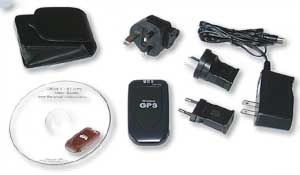 |
|
What
does it look like?
I
had seen articles about the Emtac BT GPS suggesting that it
was quite small and compared to 3 PCMCIA cards, but when you
actual handle it you realise just how small and light it actually
is.
The
top panel has the Wireless GPS branding but you will find
that the branding will change for the Socket or other OEM
versions of the receiver. Underneath the branding badge is
the GPS's internal aerial.
On
the bottom end of the unit are 3 status LEDs an on/off switch
and the power socket. On the side of the receiver is a connector
for an external MCX type aerial. |
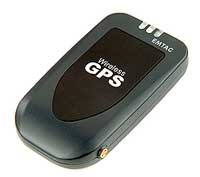
Click
here for larger picture
|
|
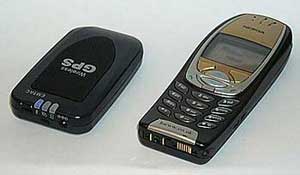 |

The
Emtac BT GPS height is a shade smaller than the Nokia 6310i,
and is as wide as the widest part of the phone. It is about
two thirds the length of the 6310.
One
important feature is that the underside of the receiver has
a strip of rubber at each end which means that it does not
wander over the dashboard when driving. |
|
Manufacturers
Technical Specifications
These specifications are provided by Emtac from their Website
|
Chipset:
SiRF Star II LP
Frequency:
L1, 1575.42 MHz.
C/A:
1.023 MHz chip rate
Channels:
12 Channel all-in-view tracking.
DGPS Source:
Default:None
Programmable: WAAS/EGNOS
System Back Up:
Built-in Lithium-Ion rechargeable battery
Antenna
Type:
Built-in Antenna (external antenna optional)
Power:
Built-in rechargeable battery and 5V DC input charging circuit
Operation
time:
Default: 6hr. (min.) After full charged, in Continuous mode
Programmable: >6hr.
*Depend on duty-cycle setting in trickle power mode
Device Size:
53(L) x 94(W) x 16(H) mm
|
Accuracy:(DGPS:None)
Position:
10 meters RMS, 25 meter CEP, without SA
Velocity:
0.1 meters/second, without SA
Time:
1 microsecond synchronized to GPS time
Datum:
WGS-84 (or by demanded)
Acquisition Rate: Open Sky and Stationary
Reacquisition:
0.1 sec., average
Cold Start:
< 80 sec., average
Warm Start:
< 45 sec., average
Hot Start:
<
10 sec., average
Altitude:
<18,000 meter
Velocity:
< 515 meter/second
Acceleration:
< 4g
|
Interface:
Connection:
Communicate with Host Platform via Bluetooth(Class2) Serial Profile
Protocol:
Default: NMEA-0183 (V2.20)- GGA(1), GSA(1), GSV(5), RMC(1)
(n): n is the update interval in seconds
Programmable: additional NMEA- VTG, GLL / SiRF
Binary |
| How
does it Connect?
This
was my first use of a Bluetooth serial device. I had experience
of using Bluetooth with both my Portable Computer and also my Nokia
6310i so connecting was not a problem.
The
CD actually has an excellent guide for connecting the Emtac BT GPS. It is full of screen pictures with simple instructions, following
these instructions resulted in a first time connection. I took the
option of creating a bond between my iPAQ and the Emtac. When bonding
you must use a passkey of '0183'. Connecting
it to the portable was much more challenging. There were no instructions
for connecting devices other than a Pocket PC. I managed to make
a connection between the Emtac very easily, but I was unable to
open the serial port. Checking the properties of the connection
I found there was no COM port assigned. OK I thought that I was
doing something silly so scanned the TDK website for FAQs or other
help. Not finding anything helpful I fired off a detailed request
for assistance from TDK support. All I ever received back from them
was an automated response acknowledging my request. I also sent
two email chasers in an attempt to get the setup working for this
review. Still no response received.
I decided not to give up on this and played around with some of the
settings with no joy. Then, feeling a bit despondent, when I was on
the phone describing the problem to a friend and attempting to
reproduce the error I suddenly found that the error did not occur and
the serial port had been opened successfully. Strange because I had
done nothing differently. Ever since then I have been able to connect
every time I have tried. Connecting
on both the iPAQ and the Toshiba now is a simple matter of ensuring
that both Bluetooth devices are switched on, then simply starting
the GPS application and opening the GPS serial port. This then opens
the connection between the two devices and reports GPS positioning
information.
The
Emtac only supports connection to a single device so the utopia
of connecting multiple devices to the receiver cannot be realised
at the moment. I was, therefore, unable to connect both the iPAQ
and the Portable PC to the Emtac at the same time. However
having said that I did manage to have 3 GPS applications open at
the same time. How did I manage to achieve this? As a result of
exchanging messages with some of the guys on the OziExplorer newsgroup
I applied a little lateral thinking and used the NMEA out feature
of Fugawi (OziExplorer has an Autopilot feature but I did not try
this). Rather than send the output to a normal serial port I sent
it to a Bluetooth serial port. I was then able to connect the iPAQ
to the Portable BT serial port, and quite happily get GPS positioning
data.
The only thing that seemed to be missing was the data providing
satellite strength information. I am still investigating this at the
moment. Even
more interestingly I accidentally opened a second GPS application
on the iPAQ and somehow that also started to receive GPS data I
haven't actually used it actively yet so I am not sure about
the stability of this set-up. The only thing I can assume is that
somehow Bluetooth is multiplexing the serial ports, I have not worked
out which end is doing the multiplexing, other than knowing that
it is not the Emtac. |
|
In
Use
The Emtac is able to connect to your PDA or PC straight out of the
box. There is no need to configure it for normal use.
I was amazed at the
speed of Fixing. The first fix straight from the factory was so
quick I didn't manage to time it (less than 2 minutes). Subsequent
cold fixes first thing in the morning take less than 60 seconds,
typically being in the 45-50 second range. The average was spoilt
by one fix which took 4 minutes 43 seconds, but this was offset
by a fix of less than 20 seconds. In general, when I get into my
car I switch the Emtac on put it on the dash start the car and hook
up the iPAQ by which time I have a fix and can start driving.
What about number of
satellites used in fixing and signal strength? Well yet again I
was surprised! With my original sleeve I would normally get a fix
on between 3 and 6 satellites with the occasional 7 sat fix. With
the new Emtac GPS sleeve (as supplied with the latest release of
co—pilot) I would normally have a fix on 5 to 8 satellites.
With the Emtac I normally get a fix on 7 to 10 satellites, with
9 and 10 being very regular. The first time this happened I really
could not believe it. I thought that maybe something was wrong,
or maybe it was a specially clear day or something. I was surprised
when the same thing happened the next day, and regularly thereafter.
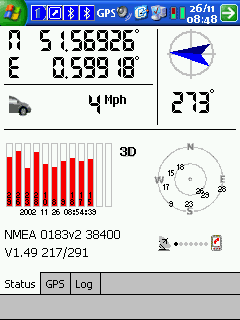 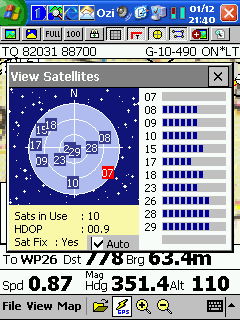
|
|
As
you can see from the above screen pictures I have achieved 10 satellite
fixes on different days using different applications.
I have also enabled
WAAS/EGNOS and attempted to get a fix. This is not so reliable as
a normal fix as you need line of sight to a single satellite, which
although being Geostationary, may not always be available. In Europe
the EGNOS system is still in test mode and may not be reliable. The screen image to the left shows a differential fix in OziExplorer,
taken with the receiver on my office windowsill.
I then decided to put
the unit to a real test to see it's capabilities. First I put the
receiver on the windowsill in my office, I often use this when testing,
though with other receivers I would only get a maximum 3 satellite
fix. The Emtac came in strongly with a 5-6 satellite fix, and I
even get a 5 satellite differential fix.
I decided to take this
one stage further and moved the receiver deeper into the office.
I ended up with the receiver on top of a filing cabinet 1.75metres
high and 3.5metres from the window. Amazingly I still had a 4 satellite
fix.
I have had similar experiences
when driving, I have found that I can get a very good signal with
the receiver in my pocket, or even on the floor between the front
seats.
|
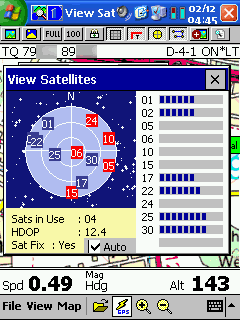 |
|
When I go out walking
I put the Emtac in the front pouch of a small camera bag with the
iPAQ just behind it. This is the only time when I have seen a degradation
of signal reception, dropping from 8-9 sats to 5-7, still a very
acceptable reception.
I have not been able
to test the Emtac in situations where there is heavy foliage as
it is now winter in the UK, when I first received the unit there
were a few leaves on the trees, but the last few went within days
of me testing, and it would be unfair to produce a comparison under
these conditions.
|
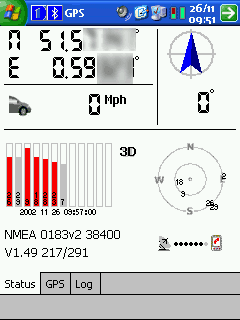 |
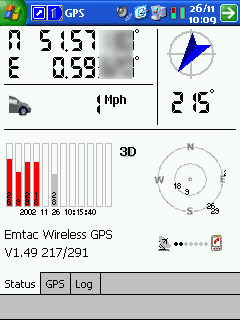 |
|
Emtac on my office windowsill
|
The Emtac receiver on top of
my filing cabinet.
|
| The one thing I have
not mentioned yet is the re-acquisition times. The other day I was
able to test this in a real environment: Driving through the Dartford
Tunnel on the M25. The satellite signal was lost as expected after
we were about 50 meters inside the tunnel, as we cam out the other
side the receiver re-fixed within seconds, far too quickly to time.
This, again, is something I have never experienced normally other
GPS receivers I have used have taken between two and ten minutes
to re-fix. |
|
Configuration
The receiver works straight out of the box so configuration is not
required, but Emtac provide a utility to allow you to monitor and
set some features of the receiver. This is provided on the CD and
is called CRUX-View.
CRUX-View is run on
the iPAQ and provides a series of 6 screens to examine the GPS receiver:
GPS Status; Position; Message; WAAS; Low power; and about.
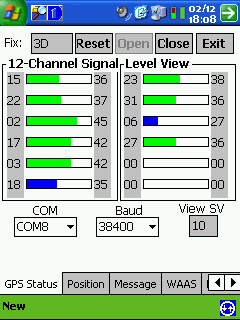 
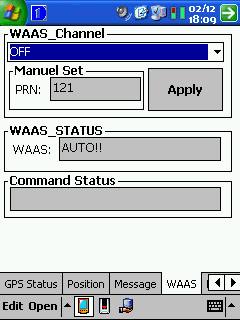 
The
main reason to use the CRUX-View utility is to set the receiver
to use the WAAS or EGNOS differential fixing to get a more accurate
position reported. The functionality of this is arguable for driving
but could become essential for other uses such as Emergency services,
municipal workers, engineers, mountaineers etc.
|
|
Power
Consumption
The Emtac is powered by an internal Li-on battery. This is charged
by connecting the the transformer provided in the package. The manufacturers
claim 6 hours continuous usage. In my trials I have found the receiver
to last for up to 8 hours and never less than 6 as specified. A
refreshing change for these figures to be quoted conservatively.
The
Emtac is provided with a power socket which has the same plug as
the iPAQ and many other 5v devices. The manual states that you should
only use the supplied charger otherwise damage may occur to your
receiver. This could be a big restriction if you need to use
the GPS over extended periods and cannot get to a power outlet.
With this in mind I contacted Itochu to determine the real position
and was told that the iPAQ car power supply was OK to use with the
Emtac, so no worries about running your battery flat.
|
What
doesn't it do ?
Those of you out there that are used to traditional handheld GPS
receivers will not find any track recording, waypoints, routing,
or navigation built in to this device. It is purely a GPS receiver. |
|
First
Impressions
The day the Emtac arrived I had to go out on business and only got
back at 8pm so didn't have much time to play with it. What I can
say immediately is that it's ability to get a fix is incredible. I am not quite sure how long it took to get the first fix from factory
delivery, I powered the Emtac on, set my stop watch and went to
make a cup of coffee. When I returned after 2 minutes the receiver
had already got a fix.
Later on I was trying
to get connected to my iPAQ with the Emtac next to me in the centre
of my lounge which is at least 3 yards if not 4 from the nearest
window and I found that I had a 5 satellite fix. I really found
that incredible, the only other receiver I had seen that could come
anywhere near this was the Garmin GPSMAP76 which could only manage
a fix on 2 satellites.
Later
on that night I enabled the WAAS and went to bed leaving the receiver
active on the windowsill of my office. The next morning I had forgotten
about the WAAS and set off in the car to the station and to take
my dog out. I was amazed at the number of satellites being fixed
by the receiver: 8-10 when I normally get 3-5. When I stopped and
switched from Tom Tom to OziExplorer I found that I had a 3D (differential)
fix on 10 satellites, (yes that really is 10 satellites). Normally
with my other GPS sleeve receiver I would be looking at 3-5 at 3G
(normal GPS fix). When entering the woods the signal dropped to
a 3G fix so obviously WAAS had kicked in and dropped out when I
entered the woods.
As regards the accuracy I set waypoints at two well defined but
small 3 foot by 3 foot locations one day, and revisited them over
the next few days, in different weather conditions. In both cases
I only had a 3G location fix no WAAS, so this should determine the
accuracy of the receiver in a variety of conditions. The following
days I managed to accurately navigate to the exact same locations
the receiver reported a 2 foot discrepancy on one occasion and 5-6
feet at other times. None of these were achieved using WAAS. I did
notice that once on the waypoint my position would shift, and was
more accurate when moving towards the waypoint. Over 5 occasions
in varying weather conditions the variance when stationary was at
most 10 feet.
|
|
OK so now the downside!
Well there is little wrong with the Emtac BT GPS receiver other
than it's reliance on battery power. This is not really a
downside as the battery can last for up to 8 hours. Only a
really long car journey or an extended hike using the receiver all
the time would deplete the batteries. Despite warnings in the manual
I have been told that the receiver can be powered from the iPAQ
cigar lighter power supply so it can be charged up during long journeys.
The
iPAQ Bluetooth manager seems to be a bit buggy. I tried
doing the sensible things like turning the iPAQ off and then back on
and found that the system had crashed and was in snail mode so a
soft reset
was required. A couple of times the BT Manager crashed when trying
to connect to the Emtac. I since re-installed the iPAQ BT manager
and have had fewer issues.
Switching
on the WAAS functionality is easy just a matter of configuring it
with the supplied utility. You need a clear view of the sky for
WAAS to work, but I did appear to be getting 3D differential fixes
today implying that WASS was working. Moving into the trees lost
the differential fix and dropped back to the 3D location fix. So
you cannot rely on getting WAAS fixes all the time.
|
|
Conclusion
Almost GPS utopia but not quite. I am not really sure if utopia
is ever achievable, but you really cannot get much closer. This
has to be the most innovative and impressive piece of new technology
in the GPS arena. Where Emtac leads surely others will follow. Bluetooth
is established as a standard for wireless communications between
phones, PDAs, Portable PCs, printers, and now GPS receivers.
The only drawbacks
that I identified were:
| 1. |
The battery life, which although was excellent and more than
sufficient for my needs, extensive driving trips or long hikes
could drain the power. However there are more issues with
power management on the PDA than there is with the Emtac.
I have been informed that there is a new product in development
which has a removable battery that could overcome these issues,
combining this with the new HP iPAQ 5450 which has better power
management may be a much better solution. |
| 2. |
The
price. £272.98 or €400 is a bit expensive for a GPS receiver
with no software. That said it is cutting edge technology and
will probably come down in price in time. The question is can
you wait? |
Wish list item:
I realise that this is 'just' a GPS receiver but to make it perfect
having the ability to record tracks would be extremely useful when
out hiking, biking or climbing. That way the receiver would remember
where you went and you would only need to switch your PDA on when
you needed to consult it for your location thus saving valuable
battery power. You could later download and manage your tracks in
the PDA or PC application.
Would I buy one? NO!!!!
Why not? Because I wouldn't send the review receiver back.
In the words of Victor Kayam "I was so impressed I bought the
company" (Remington shavers). Well I couldn't afford the company
but I made sure I purchased the receiver. I certainly would not like
to be without it, it is far better than any other GPS receiver I
have used. Christmas came early for me this year! |
|
Where can you buy them?
The Emtac web site has details of the worldwide distributor network.
You can find this list at www.emtac.com/support/
In the UK you can buy them from
|
|
|
 |
 |
 |
 |
|
|